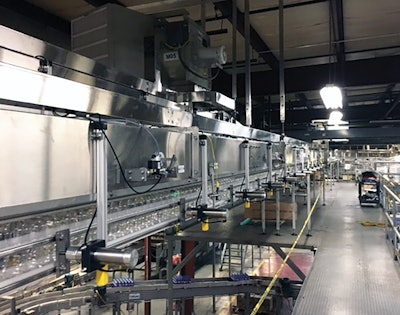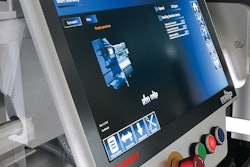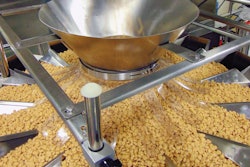
The Anysize™ automated guiderail adjustment system, the brainchild of Flexibility Engineering, solves the biggest problems associated with automatic changeovers, especially consistency over long lengths of conveyor and reliable change-part-free turns.
Comparable systems in the market include manual adjustment systems—which can be slow, labor intensive, and inaccurate—as well as electronic or pneumatic systems. But electric systems are expensive and difficult to maintain, troubleshoot, and repair, plus they consume energy while holding a position. Pneumatic systems, on the other hand, are either not flexible enough for multiple positioning or too expensive to make flexible through servo pneumatics.
Anysize is fully automated, which means no manual adjustments are involved in changeovers. The system is maintenance free, another plus in terms of low labor requirements. Changeover is fast and accurate for greater throughput along the entire length of the conveyor.
Infinite positioning within the one-to-six-inch adjustment range of Anysize provides flexibility in running a wide and changing range of package sizes. On turns, there are no change parts required as Anysize handles infinitely adjustable turns, all automatically. The system also handles multiple lanes and centering via centering rail kits. Power consumption is minimal for greater sustainability, less than one cubic foot of air is required for a typical change over. The Anysize positioning system itself is flexible and can be applied to caps, vials, neck rings, PET bottles and jars, cases, and even to positioning a manifold for an air dry system. Each new recipe can be set up quickly by the maintenance team. Anysize can be easily retrofitted to existing conveyors or installed on new ones. The cost of an Anysize system is calculated by Flexibility Engineering to be about one-third of an electric system and about one-half of a manual system.
When companies had the luxury of running just one or two product sizes on a line, conventional pneumatic positioners were a cost-effective solution for moving guiderails to different positions. As packaging operations added product sizes the limitations of pneumatics became apparent—increasing the number of two-position cylinders and the plumbing associated for each new product size simply wasn’t practical due to cost, space, maintenance, and troubleshooting overhead.
Potential problems
Long runs of conveyors, particularly from case packer to remotely located palletizer, pose significant problems for packaging operations in terms of adjusting guiderails when size formats change. Frequently, these conveyors—sometimes hundreds of feet in length—are located near ceilings and/or in tunnels and are hard to reach. Hand-crank adjustments are problematic because of the labor and time involved in adjusting sections of guiderails over hundreds of feet of conveyor. They also require maintenance to keep all the moving parts working. Everyone who has ever been associated with manual adjustments knows that it usually requires many readjusting tweaks along the entire route to get the settings right. There can be a significant amount of downtime and damaged product during the tweak-the-adjustment-dial-process. When hand adjustments are made while standing on tall ladders or finding footing inside cramped tunnels, there are safety, ergonomic, and morale issues to contend with.
The use of servo-controlled or stepper motors solves the infinite positioning accuracy, speed, and labor problems associated with manual adjustment. But electric solutions are expensive and complex. Electronics along hundreds of feet of ceiling-height conveyor are difficult to troubleshoot, repair, and maintain. Since the motors expend energy to maintain position, electrics are not an energy-efficient solution compared to Anysize, which requires no holding energy.
In coming up with the Anysize solution, the design team at Flexibility Engineering had experience in one-or two-setting pneumatic positioning of guiderails on PET bottle and case packing lines, but not with infinite positioning that the growing trend in flexible automation demanded. So they looked at the physics involved in pneumatic positioning and came up with an elegant solution involving precision characterized springs, compression force, and precise pressure control. Engineers recognized that a known force will always compress a constant-force precision spring a specific distance. The mantra at Flexibility Engineering became—pressure equals distance.
The design team began to experiment with a guiderail-positioning-unit, called appropriately enough a “positioner,” whose main components included a precision spring aligned with a quality pneumatic actuator with end bearings and seals sufficient to withstand high force over years of service. Actuator seals turned out to be one of the most critically important components within the positioner for long service life. Festo worked extensively with Flexibility Engineering on the seals issue. With accurate electronic pressure control from Festo, the actuator compresses the precision spring, which in turn moves an arm or plate a specific distance. Flexibility Engineering and Festo have worked together for years to refine the system to ensure that the pneumatic actuators and pressure controllers function with the highest possible levels of accuracy and long life. Flexibility Engineering applied for and was granted numerous U.S. and foreign patents on the Anysize pneumatically powered guiderail system.
Every precision spring is tested and characterized in terms of a uniform force-displacement curve before being mated with a pneumatic actuator in an Anysize positioner. Displacement curves can be adjusted within defined limits to the specific application. The company selects force characteristics that can be utilized over the entire pressure range. Positioners are sold with one, three, four, or six inches of extension with metric and longer stroke versions in progress. Positioners are fixed on one or both sides of a conveyor at roughly three-foot intervals. A single pneumatic line runs on either side of the conveyor with each positioner having its own air drop from the main line. This daisy chain arrangement provides for a simple, clean appearing layout. Each 150-foot section of guiderail—classified as a zone—has its own Festo electronic pressure regulator which is in a Remote Air Distribution (RAD) control cabinet.
No special power drop
RAD units run on 110 or 24 volt systems, so no special high voltage power drop is required. Also, having a low voltage system means that pneumatic and electronic systems can be combined in the same cabinet, rather than separate as is the requirement for higher voltages. A touchscreen human machine interface (HMI) is used to create and change settings for the various product sizes on the line. Up to 100 different settings can be stored; with most systems 20 is more than sufficient. PLCs communicate with the RAD unit and signal when it’s time for a new setting.
Interestingly, these 10 to 100-pound air pressure systems only require energy when a positioner moves to a new setting. Holding a setting requires virtually no measurable additional power. Position accuracy is up to + .014 inches (.35mm) for the one-inch positioner.
These guiderail adjustment systems can be retrofitted to existing conveyors—basically bolting on the positioners and programming the RAD system for each recipe—or installed as part of a new conveyor. Explosion proof and pharmaceutical grade systems are available. Flexibility Engineering sells positioners, RAD controllers, and other components as well as multi-lane, centering, and turn kits to distributors, conveyor companies, and engineering firms who then perform the installation. The company is currently signing up new OEM integrators and commercial distributors. Flexibility Engineering reports that in hundreds of thousands of hours of service and well over 100,000 positioners in service there has not been a single positioner failure.





















